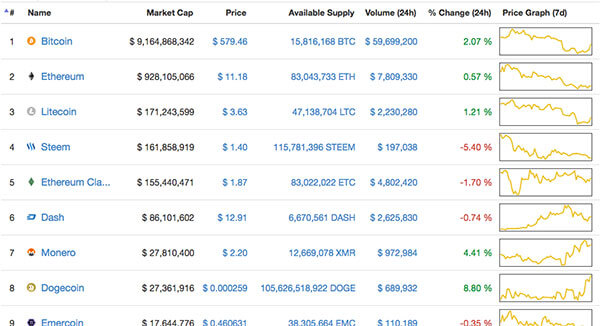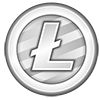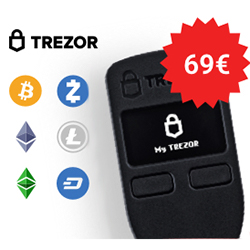 My-Bitcoin.net
My-Bitcoin.net
Actual transactions
Alternative currencies
Of course, bitcoin isn’t the only existing cryptocurrency in the world. Given the fact that the bitcoin source code is freely accessible, it very easy to copy it, rename it, adjust a few rules, such as the number of coins, the speed of mining, etc. and just release this clone into the internet world.
Today, there are hundreds of currencies with many different names. To see the full list of these currencies visit coinmarketcap.com. New currencies emerge every day, however, at the same time, many currencies cease to exist.

The biggest motivation for cloning the currency is of course to make some profit from it. The desire to repeat the success of the bitcoin is for many probably irresistible. However, most attempts are rather ridiculous.
On the other hand, it’s important to mention the fact that there are currencies that are trying to improve the features of Bitcoin in certain ways. A few examples of improvements are: increasing the speed of the network, increasing the throughput of the network, increasing the number of coins, increasing anonymity, changes in hashing etc.
Here is the list of currencies we think you might find interesting:
Litecoin
 One of the first alternatives to bitcoin. If we were to see the bitcoin as gold, then Litecoin would be the equivalent of silver. It aims for 4x speed-up in transaction verifications. This means that blocks are generated every 2.5 minutes. It increased the total number of coins 4x, from 21 million to 84 million. However, the main reason behind creating this alternative was to try to start mining bitcoins again using the PC processors. The mining shifted from using SHA-256 to using so called script, which used memory for its calculation. Manufacturing special hardware was therefore much more difficult.
One of the first alternatives to bitcoin. If we were to see the bitcoin as gold, then Litecoin would be the equivalent of silver. It aims for 4x speed-up in transaction verifications. This means that blocks are generated every 2.5 minutes. It increased the total number of coins 4x, from 21 million to 84 million. However, the main reason behind creating this alternative was to try to start mining bitcoins again using the PC processors. The mining shifted from using SHA-256 to using so called script, which used memory for its calculation. Manufacturing special hardware was therefore much more difficult.
However, using the processor didn’t last for long and the mining software was adjusted so that it could be used with graphics cards. Those had been in use for a relatively long time before even for this type of currency (using the scrypt) was developed special ASIC.
Peercoin
This currency was established in 2012. Unlike other currencies, there is no set amount of coins. It is designed to eventually attain an annual inflation rate of approx. 1% at the end of the first emission of coins. Like the bitcoin, it also uses SHA-256 for mining.
Unlike other cryptocurrencies, it doesn’t rely just on the proof-of-work for mining, but it also contains so called proof-of-stake, which credits users who already hold some coins with newly created coins. For example, someone holding 1% of all the PPC coins, gets 1% of inflation of the newly emitted coins.
Namecoin
This currency was primarily developed as decentralized DNS which could resist vagaries of the government agencies that could always delete any ‘inappropriate’ website. It uses the extension .bit which you can use to register your domain. There are fees for keeping the domain in the distributed DNS, which are deducted in the Namecoin currency.
The total number of NMC is 21 million. Like the bitcoin, this currency also uses the SHA-256 function. Apart from registering domain names, we can think of potential use of Namecoin for example in identification systems, messaging services, logging in systems, torrent trackers, etc.
Quark
Quark differs from other cryptocurrencies in that it places a great emphasis on security measures. Considering the recently discovered fact that American NSA was breaking hash function and encryption, it’s too unsafe to rely on just one cryptocurrency.
That’s why the creators of Quark had to redesign the protocol to increase security. It now uses 9 rounds of hashing from 6 hashing functions (Blake, Blue Midnight Wish, Grøstl, JH, Keccak or SHA-3 and Skein) in a random order.
Unlike the bitcoin and other currencies the transaction verification is very fast - takes only 30 seconds. Quark has a set inflation rate of 0.5% a year which mainly covers the losses. The total number of quark coins is 247 million.
Vertcoin
This currency focused on the resistance to ASIC mining. The original idea of Bitcoin was that ‘mining’ will be carried out by users in their homes, using hardware, but with the introduction of the ASIC devices, mining relocated to China, where are these devices (chips) produced.
The first attempt to resist ASIC came from Litecoin, which, instead of SHA-256, started using so called scrypt that required the use of computer memory. Producing the chip is very cheap, but if the use of memory modules is required, it makes things harder. This concept lasted for a few years, however today we’ve got ASIC even for the scrypt.
It was precisely Vercoin that reacted to this newly introduced ASIC by implementing new Scrypt-N, which dynamically changed the memory requirements so that it wasn’t possible to use this ASIC for mining and PCs had to be used again.
Dash
Used to be known as Darkcoin and XCoin. It uses a chained hashing algorithm, called X11, for mining. Same as Scrypt-N, Dash too is ASIC resistant, however, unlike Scrypt-N, it didn’t put so much strain on graphics cards (so they didn’t burn so much) making it very popular among the miners.
This currency also supports anonymity. It supports the Private Send function which mixes up inputs and outputs of the same size so that transactions can’t be traced.
Dogecoin
This cryptocurrency was introduced on December 8, 2013. It’s based on Litecoin and doesn't bring anything new. It features the Shiba Inu dog breed on its logo from the famous internet meme. Unlike other cryptocurrencies, Dogecoin was in much faster production, when many parameters indicated that by the end of 2014 there would be 100 billion coins in circulation.
This currency went viral very quickly and started to spread all over the world on the internet. In January 2014, Dogecoin trading intensity exceeded the volume of bitcoin transactions and all other cryptocurrencies together. Another interesting thing we’d like to mention here is the Dogecoin community donation of $30,000 to the Jamaican Bobsled Team. The team otherwise wouldn’t have been able to compete at the 2014 Winter Olympics in Sochi. The Dogecoin community also sponsored the car racing driver Josh Wise at NASCAR race (the symbols of Doge meme, Dogecoin and reddit social network were displayed all over the car).
Ethereum
Ethereum is a cryptocurrency inspired by the blockchain. This currency was introduced by Vitalik Buterin. It’s a public computing platform which enables running decentralized applications which are something like a virtual machine for running ‘smart contracts’.
The above mentioned smart contracts are applications with a state stored in the blockchain. They can facilitate, verify, or enforce the negotiation or performance of a contract. The result is always stored in the blockchain format. The contracts can be replicated so that they form their own autonomous structure.
Unlike Bitcoin, the creator of Ethereum is well known and is permanently striving to improve the system. This virtual currency was launched in 2015. Ethereum has recently seen enormous rise in value. The main difference between Bitcoin and Ethereum is that the latter enables creation of related chain applications.
Given its concept, Ethereum falls into the next-generation of cryptocurrencies, sometimes also called the ‘bitcoin 2.0’.
Bitcoin Price Index

 #bitcoin Tweets
#bitcoin Tweets








